The word prayaga has been traditionally used to mean "a confluence of rivers". It denoted the physical meeting point of the rivers Ganges & Yamuna in the city. An ancient tradition has it that a third river, invisible Sarasvati, also meets there with the two. Today, Sangam is a more frequently used name for the confluence.
Prayagraj meaning "the king among the five prayagas", is used as a term of respect to indicate that this confluence is the most splendid one of the five sacred confluences in India.
The religious basis for the Magh Mela is the belief that pilgrimage is a means for Prayashchit (atonement, penance) for past mistakes, the effort cleanses them of sins and that bathing in holy rivers at these festivals has a salvific value, for moksha – a means to liberation from the cycle of rebirths (samsara). According to Diane Eck – professor of Comparative Religion and Indian Studies, these festivals are "great cultural fairs" which brings people together, tying them with a shared thread of religious devotion, with an attendant bustle of commerce, trade and secular entertainment.
The Magha Mela festival is mentioned in the Mahabharata and in many major Puranas. The Magh Mela is a part of the river festivals that follow the transition of Jupiter into various zodiac signs. These river festivals – called Pushkaram (or Pushkaralu) – rotate over the year to ghats and temples along the major rivers of India, each revered as a sacred river goddess. They include the ritual bathing as well as prayers to ancestors, religious discourses, devotional music and singing, charity, cultural programs and fairs.
The city which has been innumerably mentioned in the ancient Hindu texts, and the history of the place, both mythological and factual that makes it one of the most fascinating and one among the main holy cities in India, special to the hearts of Hindus in India and abroad. It’s the mythological history according to which, when Lord Brahma was done with creating the world, offered his first sacrifice here. Hence the justification of its ancient name Prayag, meaning Place of Sacrifice. The place also holds a special significance according to the Hindu scriptures for holding the confluence of three of the most sacred rivers of India: Ganga, Yamuna, and Saraswati at Triveni Sangam, which becomes the nucleus of all celebrations of Magh Mela.
It is believed in the ancient times during an ongoing war between the demons and the demigods for the possession of the elixir of immortality, a few drops fell to earth at four places: Prayagraj, Haridwar, Nasik, and Ujjain. And it is at each of the four places that Kumbh Mela, the gathering of millions: devout and common witnesses from all over India and rest of the world, is held and is a sight like no other. Based on astrological calculations it returns to each place after a gap of twelve years, bigger each time.
The story that the drops of nectar of immortality fell near Sangam is believed by the people to have given mystical powers to the place as millions gather at the ghats to purge themselves of all sins by taking a dip in the waters and attain Moksha (Salvation). Young and old, fit and frail; all regions, castes, and creed aside, it becomes the single most brilliantly unifying experience ever. The place itself, overrun by Naga Sadhus, who never wear any clothes and are always smeared in ash; Urdhwavahurs, non-indulgent in physical pleasures; Parivajakas, having taken a vow of silence; and Shirshasins, who stand for all 24 hours and meditate, transforms as if from another realm.
Celebrations At Prayagraj Magh Mela
The Magh Mela, celebrated in Prayagraj(Allahabad) at the Triveni Sangam, venerates Lord Brahma, “The Creator,” for birthing the universe. This is a Hindu festival, rich in yajnas, prayers, and rituals. It honors the universe’s inception. It makes Prayagraj the paramount pilgrimage site, Tirtha Raj. Spanning 54 days, known as Kalpvas, this period symbolizes the cumulative years of the four yugas—Satyug, Treta, Dwapar, and Kalyug. Kalpvasis, the devout participants, engage in these practices with the belief that such dedication can cleanse past sins and offer an escape from the cycles of rebirth and karma.
Referenced in the Mahabharata and several Puranas, Magh Mela’s essence is rooted in the pursuit of atonement and spiritual liberation. Bathing in the Sangam during this time is considered a path to moksha, breaking free from the cycle of rebirth. The festival highlights are Makar Sankranti and Mauni Amavasya. They draw many devotees for the sanctifying dips, embodying the festival’s deep spiritual significance and its role in facilitating divine redemption.
The Magh Mela, with its sacred rituals and vibrant atmosphere, holds profound significance for both people and sadhvis on their spiritual journey. Central to this is the Holysnan. It is a pivotal act of faith where millions immerse themselves in the holy waters at the Sangam. This ritual is believed to purify the soul and wash away sins. It is a powerful moment of connection between the devotee and the divine. For many, it represents a symbolic rebirth free from past burdens.
Sadhvis, female ascetics devoted to a life of spiritual pursuit, find in Magh Mela a fertile ground for deep meditation and ascetic practices. It’s a time for them to engage with the wider community, impart wisdom, and lead by example in performing sacred rites and austerities. The gathering serves as a reminder of their commitment to spiritual growth and the path of enlightenment.
The Ganga Aarti, an enchanting ceremony filled with chants, lamps, and devotion, further elevates the spiritual ambiance of the Mela. You can witness the aarti at dusk by the riverbank. It is certainly a mesmerizing experience, reinforcing the bond between the individual and the universe. This is a moment that encapsulates the essence of the Magh Mela—a celebration of faith, a journey towards higher consciousness, and a collective quest for divine blessings.
For both pilgrims and sadhvis, the Magh Mela is more than an event; it’s a journey of self-discovery, a pathway to spiritual awakening, and a chance to experience the divine in the bustling world.
Prayagraj Magh Mela 2026 major Bathing Dates
Kalpvas is an integral tradition of the Magh Mela. It involves devotees living near the Sangam for an entire month. The devotees dedicate themselves to spirituality. This period is marked by austerity, daily rituals, and meditation. It reflects a deep commitment to personal growth and divine connection. Observers adhere to a disciplined lifestyle. They take holy baths in the early morning, participate in prayers, and consume simple food. The spiritual benefits of observing Kalpvas are profound. It’s believed to purify the soul, foster self-discipline, and bring the devotee closer to moksha, or liberation. Kalpvas serves as a retreat from worldly distractions. It offers a unique opportunity for introspection, spiritual awakening, and attaining inner peaceThe Kumbh Mela comprises of many rituals including bathing ritual, which by far is the most significant ritual performed at Kumbh. Millions of pilgrims take part in the Kumbh bathing ritual at the Triveni Sangam. Performing this sacred ceremony is in accordance with the belief that by submerging oneself in the holy waters, one is purged of all their sins, release themselves and their ancestors from the cycle of rebirth and ultimate attainment of Moksha. Along with the bathing ritual, the pilgrims also worship on the banks of the holy river and participate in discourses from various sadhus and saints.
| Date (2026) | Day | Event |
| 3rd January | Saturday | Paush Purnima |
| 14th January | Wednesday | Makar Sakranti |
| 18th January | Sunday | Mauni Amavasya |
| 23rd January | Friday | Basant Panchami |
| 1st February | Sunday | Maghi Poornima |
| 15th February | Sunday | Maha Shivratri |
Paush Purnima
As per Hinduism, revering and offering prayers to the Moon and the Sun help devotees to fulfil their wishes and get blessings. Bathing in Sangam is also observed by many devotees on Paush Purnima. Lord Surya (Sun) is also revered on Paush Purnima, as salvation is believed to result when water is offered to the Lord and prayers are performed.
The Magh Mela’s unofficial beginning is marked by this day. This day also marks the beginning of Kalpvasa
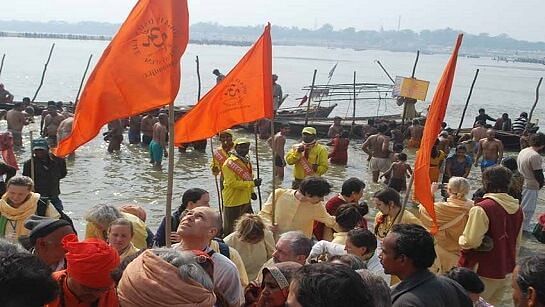
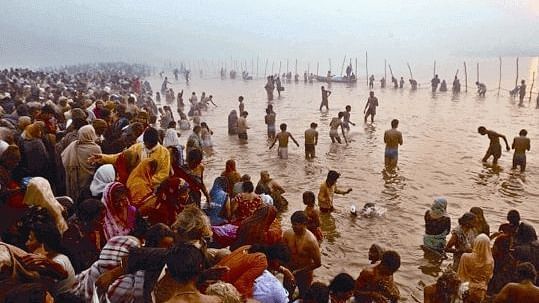
Makar Sankranti
Makara Sankranti is regarded as important for spiritual practices and accordingly, people take a holy dip in Sangam, Prayagraj. The bathing is believed to result in merit or absolution of past sins. They also pray to the Sun and give thanks for their successes and prosperity
This day marks the entry of Sun in its next astronomical position as per the Hindu calendar.
Mauni Amavasya
It is widely believed that on this date the planetary positions are most favorable for bathing in the holy river. On this day, Rishabh Dev, considered as the first sage broke his long vow of silence and bathed in the holy waters at Sangam. Maximum number of pilgrims Visit Sangam this day.
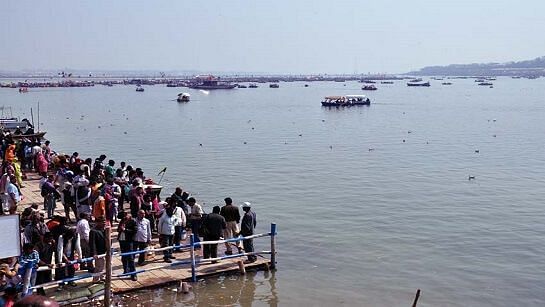

Basant Panchami
This day is indicative of the changing of seasons and marks the arrival of Goddess of Knowledge Saraswati as per Hindu Mythology. Kalpavasis wear yellow colored clothes this day to mark the importance of Basant Panchami.
Maghi Purnima
This day is known for its association with the worship of Guru Brahaspati and the belief that Hindu god Gandharva travels from the heavens to Sangam. This day sees a surge in pilgrims at the holy ghats owing to the belief that they will be guided to heaven in their humanly form.
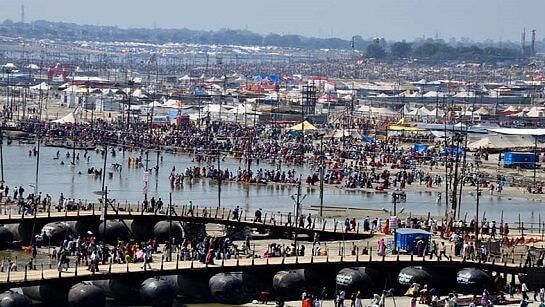
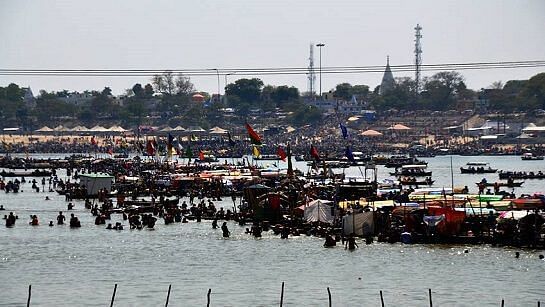
Mahashivratri
This day is symbolic of the last holy bath of the Kalpvasis and is directly related to Lord Shankar. As per mythology, this day is awaited in the heavens as well.